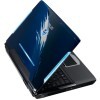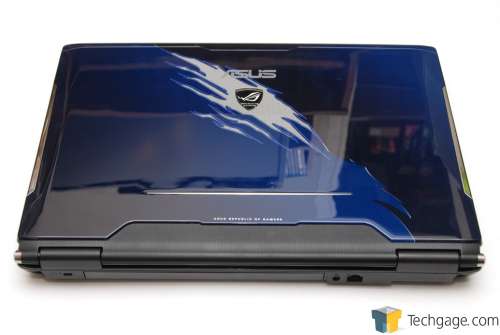- Qualcomm Launches Snapdragon 4 Gen 2 Mobile Platform
- AMD Launches Ryzen PRO 7000 Series Mobile & Desktop Platform
- Intel Launches Sleek Single-Slot Arc Pro A60 Workstation Graphics Card
- NVIDIA Announces Latest Ada Lovelace Additions: GeForce RTX 4060 Ti & RTX 4060
- Maxon Redshift With AMD Radeon GPU Rendering Support Now Available
ASUS G51J 3D 15.6″ Gaming Notebook

The term “3D” has been used quite a bit over the past couple of months, and as it stands today, there’s a fair bit of content available to those with capable hardware. But on the mobile side of things, support is just beginning to creep in. The first available option was from ASUS, with its G51J 3D, and we’re taking a look at it here.
Page 1 – Introduction
This past fall, I spent quite a bit of time with ASUS’ G51Vx 15.6" notebook, one that came in at just $999, but delivered a sweet gaming experience. In the end, there was almost nothing I disliked about the notebook, and as a result, I heartily awarded it one of our Editor’s Choice awards. Even today, I still have a couple of friends who mention that model from time to time, as they had some hands-on experience with it. When a notebook leaves an impression like that, it must be one heck of a good notebook.
A mere month after we reviewed the G51Vx, ASUS came out of nowhere with the G51J 3D. Like all of the other G51 models I’ve seen so far, the G51J 3D has near-identical design cues to previous models, and the same could be said for the layout. Compared directly to the model we looked at a couple of months ago, the G51J 3D at first glance looks like the exact same notebook.
But under the hood, the same can’t be said. Compared to the G51Vx, the G51J 3D has an improved processor, upgraded chipset, twice the number of hard drives, an upgraded wireless adapter and of course, one of the more unique displays on the market. The reason? The “3D” in the title, of course. In order for a display of any sort to deliver proper 3D, it must be at least 120Hz, which this one is. There are only two notebooks that I know of to have a 120Hz screen, the other being a model from Acer (which also touts 3D).

Adding “3D” to a notebook, or desktop, isn’t that easy. You need the support to have anything work. Since one company already has a foot in the 3D scheme, NVIDIA, ASUS has partnered up with the company in order to deliver the full 3D experience here. What that essentially means is that the G51J 3D comes bundled with NVIDIA’s 3D Vision kit (IR receiver and glasses), and various demos/applications to help put it all to good use.
Closer Look at ASUS’ G51J 3D
We’ll touch up a bit more on the 3D feature on the last two pages, but for now we’ll take a quick tour around the notebook and see all of what it offers. As you can see from the stock image above, and photo below, the G51J 3D has one huge difference compared to the G51Vx… the color. Blue is my favorite color, so it’s not too hard for me to prefer the color scheme here. Whether or not you like it obviously comes down to opinion.
Compared to the G51Vx, nothing at all is different here. The same chiclet keyboard has returned, and so has the trackpad (which is great, because it’s one of the best I’ve ever used). Altec Lansing’s audio system has again returned, and you can see two of the front speakers up nearer to the display.
There’s never much to really say about a trackpad, but the one used on the G51 is, to me, almost perfect. I almost wish the two “mouse” buttons extruded just a bit, but it’s not a deal-breaker. The pad itself is matte, and doesn’t bother the fingers after long periods of use. Nor does it get too hot, due to the creative internal design of the notebook. Like most other notebook trackpads, this one includes a “scroll wheel”, but I’ve never found one that was truly simple to use, and this one is no exception.
Here you can see the keyboard up-close, and begin to fully understand its design. This chiclet style, I admit, is pretty neat. I didn’t think I’d ever like it, but it’s grown on me, and in some regards, I prefer it. Nothing will quite beat the tactile feedback of an actual desktop keyboard, but for a notebook, this is great. For the record, the dust seen in the picture isn’t included.
Above the right-hand side of the keyboard is a variety of buttons, some touch. Not counting the keyboard status keys to the absolute left, the Republic of Gamers logo controls whether or not 3D Vision is enabled, while the button in the middle controls the power scheme. Finally, the touchpad button naturally allows you to enable and disable the touchpad, which is ideal if you are planning to use a mouse.
Most ASUS notebooks today support Splashtop Linux, and the G51J 3D is no exception. If you just want to get something done fast, you can quickly boot up into this environment by pushing the power button with a thunderbolt in it. The other power button boots you as normal.
With its $1,699 price tag, I was hoping that the G51J 3D featured a Blu-ray drive, but no cigar. The model does officially feature it as an option, but I haven’t found that configuration available online. Nevertheless, the model we tested including a fast DVD-RW drive, full audio ports and two USB ports on the right-hand side.
On the opposite end we can find two more USB ports, HDMI, eSATA, FireWire, and way at the top, VGA.
With this final photo, you can see the rather hefty hinge, along with the LAN port and AC power adapter port.
Overall, I have nothing truly bad to say about the G51, but I could have told you that before I even received this particular model. After all, in overall design, it’s nearly identical to the G51Vx which I spent about two months with this past fall. The G51J 3D is again a very well-built notebook, and “flimsy” is a word you must drop from your vocabulary when you pick one up.
Support our efforts! With ad revenue at an all-time low for written websites, we're relying more than ever on reader support to help us continue putting so much effort into this type of content. You can support us by becoming a Patron, or by using our Amazon shopping affiliate links listed through our articles. Thanks for your support!













